Evolution of Tourism in Natural Destinations and Dynamic Sustainable Thresholds over Time
Abstract
:1. Introduction
- Can the combined TALC and Purism Scale be used to define a carrying capacity thresholds for different visitor types and a destination as whole?
- What generic factors drive the attraction of a natural destination for different visitor types over time?
- How do infrastructure and services influence a destination development over time?
- Identify the key factors triggering changes in natural destination using the Purism Scale approach.
- Design a Causal Loop Diagram in order to frame and structure a holistic overview of the key factors identified and their causal relationships of a natural destinations.
- Clarify the complex interplay between the identified factors and triggers affecting transitions processes between sustainable thresholds of a natural destination system over time coupled to Butler’s TALC approach.
2. Methods
2.1. Causal Loop Diagram Modelling
2.2. Limitations
3. Results
3.1. Causal Loop Analysis
3.2. Key Factors and System Triggers
3.3. Qualitative Impact Loop Analysis
3.4. Optimum Size of Infrastructure and Tourism Carrying Capacity
4. Discussion and Conclusions
4.1. Management Implication for Natural Destinations and Dynamic Sustainable Thresholds
4.2. Concluding Remark
- Define the type of tourism desired and the acceptable level of exploitation.
- Define what constitutes Attractiveness in terms of key items at the natural destination in relation to its surrounding environment and natural resources.
- Have a clear understanding what the natural limitations (thresholds/carrying capacity) are (water supply, erosion risks, land availability, etc) on overshoot on natural capital and irreversibility of Environmental impact.
- Define what Visitor types are desirable for the natural site development according to the purism scale.
- Define and understand what the Popularity of site is for the natural destination evolution in order to anticipate possible visitor types stage transition.
- Stop and go approach to all Tourism infrastructure development in order to minimise the risk of unnoticed irreversible encroachment in small steps on the natural destination threshold [26].
- Active monitoring of predefined items in order to avoid undetected encroachment in small steps of infrastructure development that is not according to the destination sustainable long-term plan.
Author Contributions
Funding
Acknowledgments
Conflicts of Interest
References
- UNWTO International Tourist Arrivals up 4% Reach a Record 1.2 Billion in 2015. Available online: http://media.unwto.org/press-release/2016-01-18/international-tourist-arrivals-4-reach-record-12-billion-2015 (accessed on 13 November 2016).
- UNEP Impacts of Tourism. Available online: http://www.unep.org/resourceefficiency/Business/SectoralActivities/Tourism/FactsandFiguresaboutTourism/ImpactsofTourism/tabid/78774/Default.aspx (accessed on 15 February 2015).
- Newsome, D.; Moore, S.; Dowling, R.K. Natural Area Tourism: Ecology, Impacts and Management; Channel View Publications: Bristol, UK, 2012. [Google Scholar]
- Ólafsdóttir, R.; Runnström, M.C. Assessing hiking trails condition in two popular tourist destinations in the Icelandic highlands. J. Outdoor Recreat. Tour. 2013, 3–4, 57–67. [Google Scholar] [CrossRef]
- Butler, R.W.; Lew, A.; Hall, M.; Williams, A.M. The Tourism Area Life Cycle in the Twenty-First Century. In A Companion to Tourism; Blackwell: Hoboken, NJ, USA, 2004; pp. 159–169. [Google Scholar]
- Williams, P. Frameworks for Assessing Tourism’s Environmental Impacts. In Travel, Tourism and Hospitality Research. A Handbook for Managers and Researchers; Ritchie, J.R.B., Goeldner, C.R., Eds.; Wiley and Sons: Hoboken, NJ, USA, 1994. [Google Scholar]
- Butler, R.W. The concept of a tourist area cycle of evolution: Implications for management of resources. Can. Geogr. 1980, 24, 5–12. [Google Scholar] [CrossRef]
- Kavallinis, I.; Pizam, A. The Environmental Impacts of Tourism—Whose Responsibility Is It Anyway? The Case Study of Mykonos. J. Travel Res. 1994, 33, 26–32. [Google Scholar] [CrossRef]
- Salerno, F.; Viviano, G.; Manfredi, E.C.; Caroli, P.; Thakuri, S.; Tartari, G. Multiple Carrying Capacities from a management-oriented perspective to operationalize sustainable tourism in protected areas. J. Environ. Manag. 2013, 128, 116–125. [Google Scholar] [CrossRef] [PubMed]
- Butler, R. Mature tourist destinations: Can we recapture and retain the magic. In Renovación y Reestructuración de Destinos Turísticos en Áreas Costeras: Marco de Análisis, Procesos, Instrumentos y Realidades; Fernando Vera Rebollo, J., Rodríguez Sánchez, I., Eds.; Universitat de València: Valencia, Spain, 2012; pp. 19–36. [Google Scholar]
- Butler, R.W. The resort cycle two decades on. In Tourism in the 21st Century: Reflections on Experience; Faulkner, B., Laws, E., Mosscardo, G., Eds.; Continuum: London, UK, 2000; pp. 284–299. [Google Scholar]
- Butler, R. Tourism in the future: Cycles, waves or wheels? Futures 2009, 41, 346–352. [Google Scholar] [CrossRef]
- Ólafsdóttir, R.; Sæþórsdóttir, A.D.; Runnström, M.H. Purism Scale Approach for Wilderness Mapping in Iceland. In Mapping Wilderness; Craver, S., Fritz, S., Eds.; Springer: Dortrecht, The Netherlands, 2016. [Google Scholar]
- Sæþórsdóttir, A.D. Planning Nature Tourism in Iceland based on Tourist Attitudes. Tour. Geogr. 2010, 12, 25–52. [Google Scholar] [CrossRef]
- Hendee, J.; Catton, W.R.; Marion, L.D.; Brockman, L.D. Wilderness Users in the Pacific Northwest—Their Characteristics, Values, and Management Preferences; Forgotten Books: London, UK, 1968; p. 100. [Google Scholar]
- Stankey, G.H. Visitor Perception of Wilderness Recreation Carrying Capacity; Intermountain Forest & Range Experiment Station, USDA Forest Service: Ogden, UT, USA, 1973; p. 61. [Google Scholar]
- Haraldsson, H.V.; Ólafsdóttir, R. Simulating vegetation cover dynamics with regards to long-term climatic variations in sub-arctic landscapes. Glob. Planet. Chang. 2003, 38, 313–325. [Google Scholar] [CrossRef]
- Haraldsson, H.V. Introduction to Systems Thinking and Causal Loop Diagrams; Lund University, Department of Chemical Engineering: Lund, Sweden, 2004; pp. 1–49. [Google Scholar]
- Haraldsson, H.V.; Sverdrup, H.U. Finding simplicity in complexity in biogeochemical modelling. In Environmental Modelling: Finding Simplicity in Complexity; Wainwright, J., Mulligan, M., Eds.; Wiley: New York, NY, USA, 2004; pp. 211–223. [Google Scholar]
- Maani, K.E.; Cavana, R.Y. Systems Thinking and Modelling: Understanding Change and Complexity; Pearson Education: London, UK, 2000. [Google Scholar]
- Forrester, J.W. Industrial Dynamics; Productivity Press: Cambridge, MA, USA, 1961; ISBN 0-915299-88-7. [Google Scholar]
- Vennix, J.A.M. Group Model Building: Facilitating Team Learning Using System Dynamics; Wiley: Chichester, UK, 1996; ISBN 0-471-95355-5. [Google Scholar]
- Vennix, J.A.M. Group Model-Building: Tackling Messy Problems. Syst. Dyn. Rev. 1999, 15, 379–401. [Google Scholar] [CrossRef]
- Rodrigues, A.G.; Williams, T.M. System Dynamics in Project Management: Assessing the Impacts of Client Behaviour on Project Performance. J. Oper. Res. Soc. 1998, 49, 2–15. [Google Scholar] [CrossRef]
- Haraldsson, H.V.; Ólafsdóttir, R. A novel modelling approach for evaluating the preindustrial natural carrying capacity of human population in Iceland. Sci. Total Environ. 2006, 372, 109–119. [Google Scholar] [CrossRef]
- Haraldsson, H.V.; Sverdrup, H.U.; Belyazid, S.; Holmqvist, J.; Gramstad, R.C. The tyranny of small steps: A reoccurring behaviour in management. Syst. Res. Behav. Sci. Off. J. Int. Fed. Syst. Res. 2008, 25, 25–43. [Google Scholar] [CrossRef]
- Hovmand, P.; Gillespie, D.; Levin, B.; Proctor, E.; McFarland, D.; Haywood, S.; Goon, B. Science Meets Policy Practices. Dangerfield, D.C., Ed.; 2008. Available online: https://www.systemdynamics.org/assets/conferences/2008/proceed/papers/HOVMA418.pdf (accessed on 14 December 2018).
- Hovmand, P.S.; Ford, D.N. Sequence and timing of three community interventions to domestic violence. Am. J. Community Psychol. 2009, 44, 261–272. [Google Scholar] [CrossRef] [PubMed]
- Luna-Reyes, L.F.; Andersen, D.L. Collecting and Analyzing Qualitative Data for System Dynamics: Methods and Models. Syst. Dyn. Rev. 2003, 19, 271–296. [Google Scholar] [CrossRef]
- Gill, R.A. An Integrated Social Fabric Matrix/System Dynamics Approach to Policy Analysis. Syst. Dyn. Rev. 1996, 12, 167–181. [Google Scholar] [CrossRef]
- Senge, P.M. System Dynamics and the Learning Organization; Pegasus Communications: Encino, CA, USA, 1995. [Google Scholar]
- Kim, D.H. Systems archetypes as dynamic theories. Syst. Think. 1995, 6, 6–9. [Google Scholar]
- Braun, W. The system archetypes. System 2002, 2002, 27. [Google Scholar]
- Kim, D.H. System Archetypes at a Glance. Syst. Think. 1992, 3, 5. [Google Scholar]
- BenDor, T.K.; Kaza, N. A theory of spatial system archetypes. Syst. Dyn. Rev. 2012, 28, 109–130. [Google Scholar] [CrossRef]
- Forrester, J.W. The System Dynamics National Model: Macrobehavior from Microstructure; Milling, P.M., Zahn, E.O.K., Eds.; Springer: Berlin/Heidelberg, Germany, 1989; pp. 3–12. [Google Scholar]
- Hirsch, G.B.; Immediato, C.S. Microworlds and Generic Structures as Resources for Integrating Care and Improving Health. Syst. Dyn. Rev. 1999, 15, 315. [Google Scholar] [CrossRef]
- Mrotzek, M.; Ossimitz, G. Catastrophe Archetypes—Using System Dynamics to Build an Integrated Systemic Theory of Catastrophes. 2008. Available online: http://citeseerx.ist.psu.edu/viewdoc/download?doi=10.1.1.408.8248&rep=rep1&type=pdf (accessed on 14 December 2018).
- Banson, K.E.; Nguyen, N.C.; Bosch, O.J. Using system archetypes to identify drivers and barriers for sustainable agriculture in Africa: A case study in Ghana. Syst. Res. Behav. Sci. 2016, 33, 79–99. [Google Scholar] [CrossRef]
- Hardin, G. The tragedy of the commons. Science 1968, 162, 1243–1248. [Google Scholar] [PubMed]
- Meadows, D.H.; Meadows, D.L.; Randers, J.; Behrens, W.W., III. The Limits to Growth: A Report for the Club of Rome’s Project on the Predicament of Mankind; Universe Books: New York, NY, USA, 1972; ISBN 0-87663-165-0. [Google Scholar]
- Fritz, R.G. Strategic Planning with a System Dynamics Model for Regional Tourism Site Development. Rev. Reg. Stud. 1989, 19, 57–71. [Google Scholar]
- Walker, P.; Greiner, R. Systems Thinking in Tourism: Out-Learning the Competitors. 1999. Available online: https://www.systemdynamics.org/assets/conferences/1999/PAPERS/PARA218.PDF (accessed on 14 December 2018).
- Georgantzas, N.C. Tourism Dynamics: Cyprus’ Hotel Value Chain and Profitability. Syst. Dyn. Rev. 2003, 19, 175–212. [Google Scholar] [CrossRef]
- Xu, H.; Dai, S. A system dynamics approach to explore sustainable policies for Xidi, the world heritage village. Curr. Issues Tour. 2012, 15, 441–459. [Google Scholar] [CrossRef]
- Ran, W. A System Dynamics Approach to Exploring Sustainable Tourism Development. Husemann, E., Lane, D., Eds.; 2012. Available online: https://www.systemdynamics.org/assets/conferences/2012/proceed/papers/P1402.pdf (accessed on 14 December 2018).
- Soufivand, M.; Bivona, E.; Alessi, M. A System Dynamics Approach to Enhance Tourism Service Delivery Performance through Value Co-Creation; Eberlein, R., Martinez-Moyano, I.J., Eds. 2013. Available online: https://www.semanticscholar.org/paper/A-System-Dynamics-Approach-to-Enhance-Tourism-Value-Soufivand-Alessi/334ea6576adaefd5f673eb987dbcd61caa2d5e32 (accessed on 14 December 2018).
- Kim, S.R.; Lee, S.D. An Analysis of Tourist Participation Restoration-Ecotourism through Systems Thinking. IOP Conf. Ser. Earth Environ. Sci. 2018, 151, 012015. [Google Scholar] [CrossRef]
- Haraldsson, H. Developing Methods for Modelling Procedures in System Analysis and System Dynamics. Ph.D. Thesis, Lund University, Lund, Sweden, 2005. [Google Scholar]
- Richardson, G.P.; Alexander, L.; Pugh, I. Introduction to System Dynamics Modeling with DYNAMO; Productivity Press: Cambridge, MA, USA, 1981; ISBN 0-262-18102-9. [Google Scholar]
- Sterman, J.D. Business Dynamics: Systems Thinking and Modeling for a Complex World; Irwin/McGraw-Hill: Boston, MA, USA, 2000; ISBN 0072311355. [Google Scholar]
- Roberts, N.H.; Andersen, D.F.; Deal, R.M.; Grant, M.S.; Shaffer, W.A. Introduction to Computer Simulation; Pegasus Communications: Waltham, MA, USA, 1981. [Google Scholar]
- Binder, T.; Vox, A.; Belyazid, S.; Haraldsson, H.V.; Svensson, M.G. Developing System Dynamics Models from Causal Loop Diagrams. 2004. Available online: https://pdfs.semanticscholar.org/cf00/b9084b05ba357bf0c5fa7a5b9cc1b5695015.pdf (accessed on 14 December 2018).
- Burns, J.R.; Musa, P. Structural Validation of Causal Loop Diagrams. 2001. Available online: https://www.systemdynamics.org/assets/conferences/2001/papers/Burns_1.pdf (accessed on 14 December 2018).
- Wolstenholme, E.F. Qualitative vs Quantitative Modelling: The Evolving Balance. J. Oper. Res. 1999, 50, 422–428. [Google Scholar] [CrossRef]
- Wolstenholme, E.F.; Coyle, R.G. The Development of System Dynamics as a Methodology for System Description and Qualitative Analysis. J. Oper. Res. Soc. 1983, 7, 569–581. [Google Scholar] [CrossRef]
- Lorenz, U.; Haraldsson, H.V. Impact Assessment of Global Megatrends: Two Case Studies Connecting Global Megatrends to Regional Topics; Swedish Environmental Protection Agency: Stockholm, Sweden, 2014. [Google Scholar]
- Mai, T.; Maani, K. Systems Thinking for Sustainable Tourism in the Cat Ba Biosphere Reserve of Viet Nam. 2010. Available online: https://www.systemdynamics.org/assets/conferences/2010/proceed/papers/P1312.pdf (accessed on 14 December 2018).
- Mai, T.; Smith, C. Scenario-based planning for tourism development using system dynamic modelling: A case study of Cat Ba Island, Vietnam. Tour. Manag. 2018, 68, 336–354. [Google Scholar] [CrossRef]
- Neumann, K.; Anderson, C.; Denich, M. Participatory, explorative, qualitative modeling: Application of the iMODELER software to assess trade-offs among the SDGs. Economics 2018, 12, 1–19. [Google Scholar] [CrossRef]
- Haraldsson, H.; Wiktorsson, M. Understanding the Policy Implementation Deficit of the Swedish Environmental Quality Objectives System. Davidsen, P., Haraldsson, E., Eds.; 2014. Available online: https://www.systemdynamics.org/assets/conferences/2014/proceed/papers/P1424.pdf (accessed on 14 December 2018).
- Haraldsson, H.V.; Sverdrup, H.; Belyazid, S.; Sigurdsson, B.D.; Halldórsson, G. Assessment of effects of afforestation on soil properties in Iceland, using Systems Analysis and System Dynamic methods. Icel. Agric. Sci. 2007, 20, 107–123. [Google Scholar]
- Moxnes, E. The Art of Causal Loop Diagramming. In Proceedings of the 1984 International System Dynamics Conference, Oslo, Norway, June 1984; pp. 200–204. [Google Scholar]
- Kim, D.H. Using Causal Loop Diagrams to Make Mental Models Explicit. Syst. Think. 1994. Available online: https://thesystemsthinker.com/using-causal-loop-diagrams-to-make-mental-models-explicit/ (accessed on 14 December 2018).
- Schaffernicht, M. Causal loop diagrams between structure and behaviour: A critical analysis of the relationship between polarity, behaviour and events. Syst. Res. Behav. Sci. 2010, 27, 653–666. [Google Scholar] [CrossRef]
- Sarah, R.; O’Brien, A.; Haslett, T. Learning from Loops—Applying CLD to Identify Leverage Points as Organizational Learning. 2006, p. 110. Available online: https://www.researchgate.net/publication/239909587_Learning_from_Loops_-_Applying_CLD_to_Identify_Leverage_Points_as_Organizational_Learning (accessed on 14 December 2018).
- Wardman, K.T. Selecting Variable Names for Causal Loop Diagrams. Syst. Think. 1994. Available online: https://thesystemsthinker.com/selecting-variable-names-for-causal-loop-diagrams/ (accessed on 14 December 2018).
- Haraldsson, H.V.; Sverdrup, H. On Aspects of System Analysis and Dynamics Workflow. 2005, p. 79. Available online: https://www.systemdynamics.org/assets/conferences/2005/proceed/papers/HARAL310.pdf (accessed on 14 December 2018).
- Ólafsdóttir, R.; Runnström, M.C. A GIS approach to evaluating ecological sensitivity for tourism development in fragile environments. A case study from SE Iceland. Scand. J. Hosp. Tour. 2009, 9, 22–38. [Google Scholar] [CrossRef]
- Tverijonaite, E.; Ólafsdóttir, R.; Thorsteinsson, T. Accessibility of protected areas and visitor behaviour: A case study from Iceland. J. Outdoor Recreat. Tour. 2018, 24, 1–10. [Google Scholar] [CrossRef]
- Cságoly, Z.; Sæþórsdóttir, A.D.; Ólafsdóttir, R. Tourism changing the edge of the wild. J. Outdoor Recreat. Tour. 2017, 17, 1–8. [Google Scholar] [CrossRef]
- Ólafsdóttir, R.; Sæþórsdóttir, A.D.; Noordhuizen, J.; Nijkrake, W. Sustainable Leisure Landscapes in Icelandic Rural Communities: A Multidisciplinary Approach. J. Manag. Sustain. 2018, 8, 54–64. [Google Scholar] [CrossRef]
- Sheehan, L.; Ritchie, J.R.B.; Hudson, S. The Destination Promotion Triad: Understanding Asymmetric Stakeholder Interdependencies among the City, Hotels, and DMO. J. Travel Res. 2007, 46, 64–74. [Google Scholar] [CrossRef]
- Presenza, A.; Del Chiappa, G.; Sheehan, L. Residents’ engagement and local tourism governance in maturing beach destinations. Evidence from an Italian case study. J. Destin. Mark. Manag. 2013, 2, 22–30. [Google Scholar] [CrossRef]
- Ryan, C. Equity, management, power sharing and sustainability—Issues of the ‘new tourism’. Tour. Manag. 2002, 23, 17–26. [Google Scholar] [CrossRef]
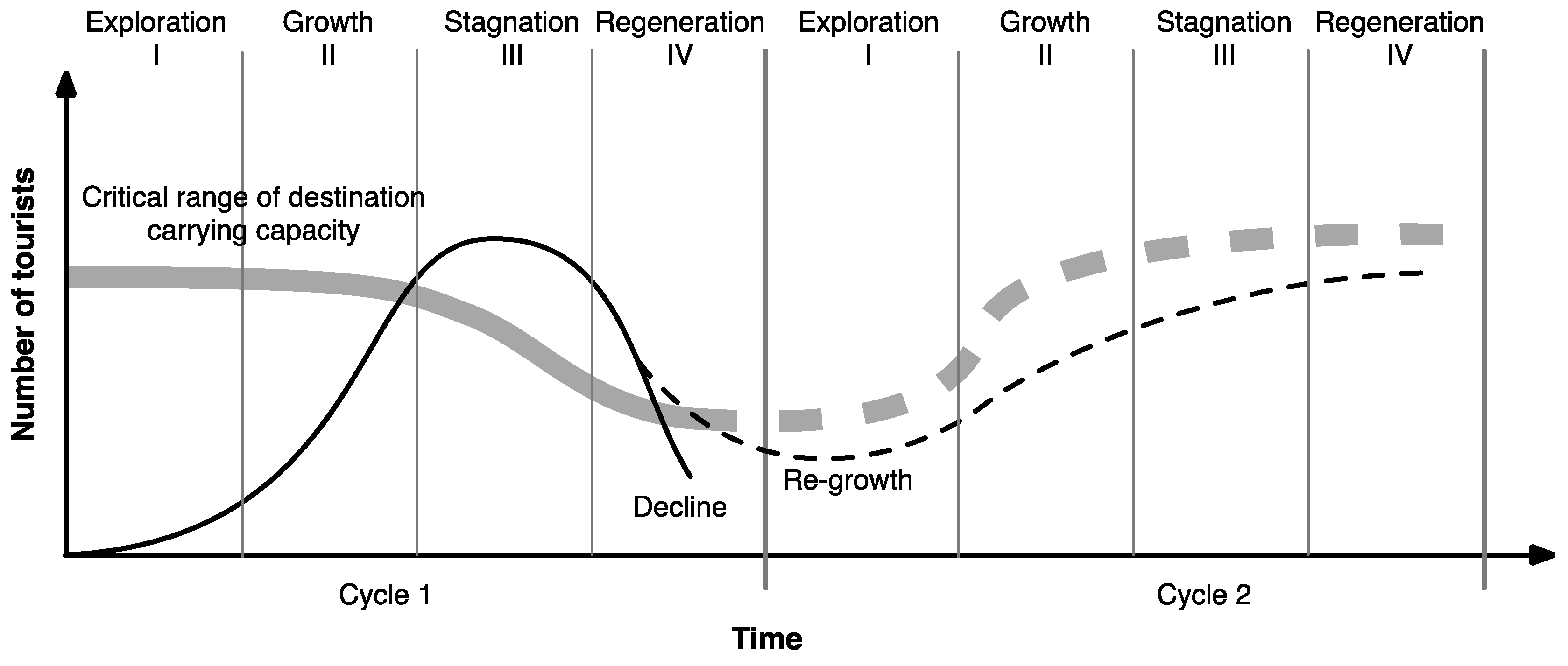
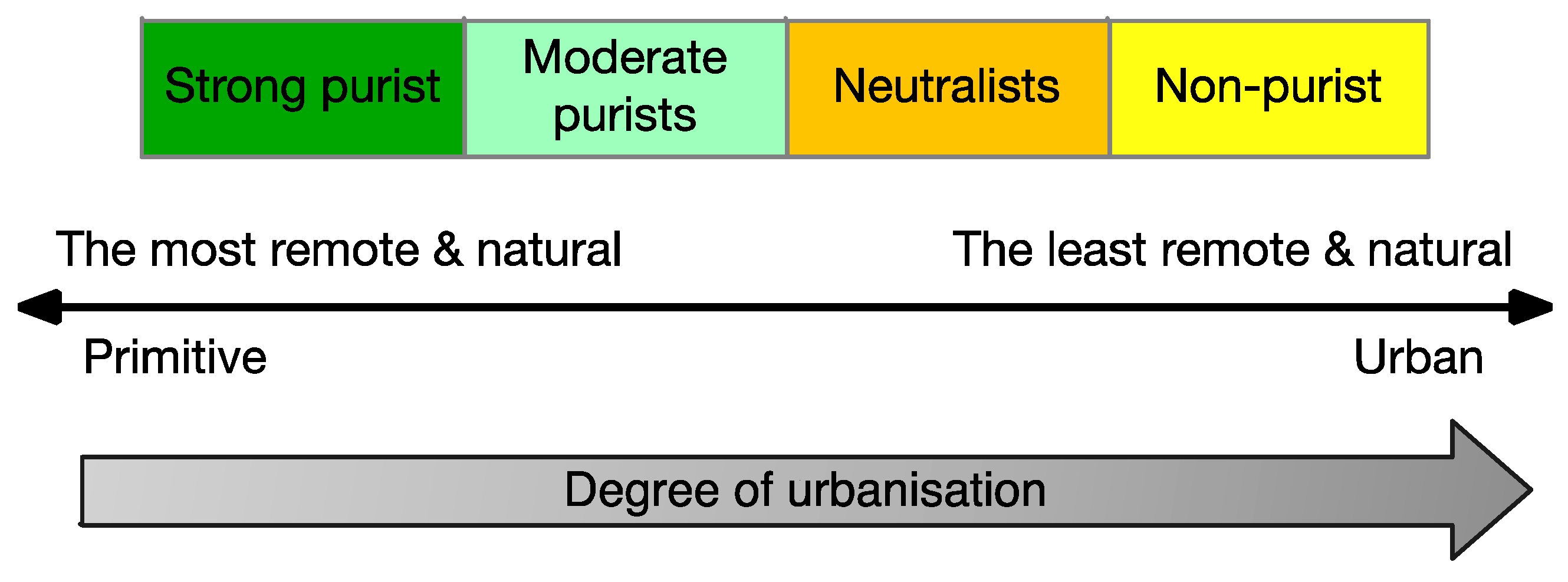
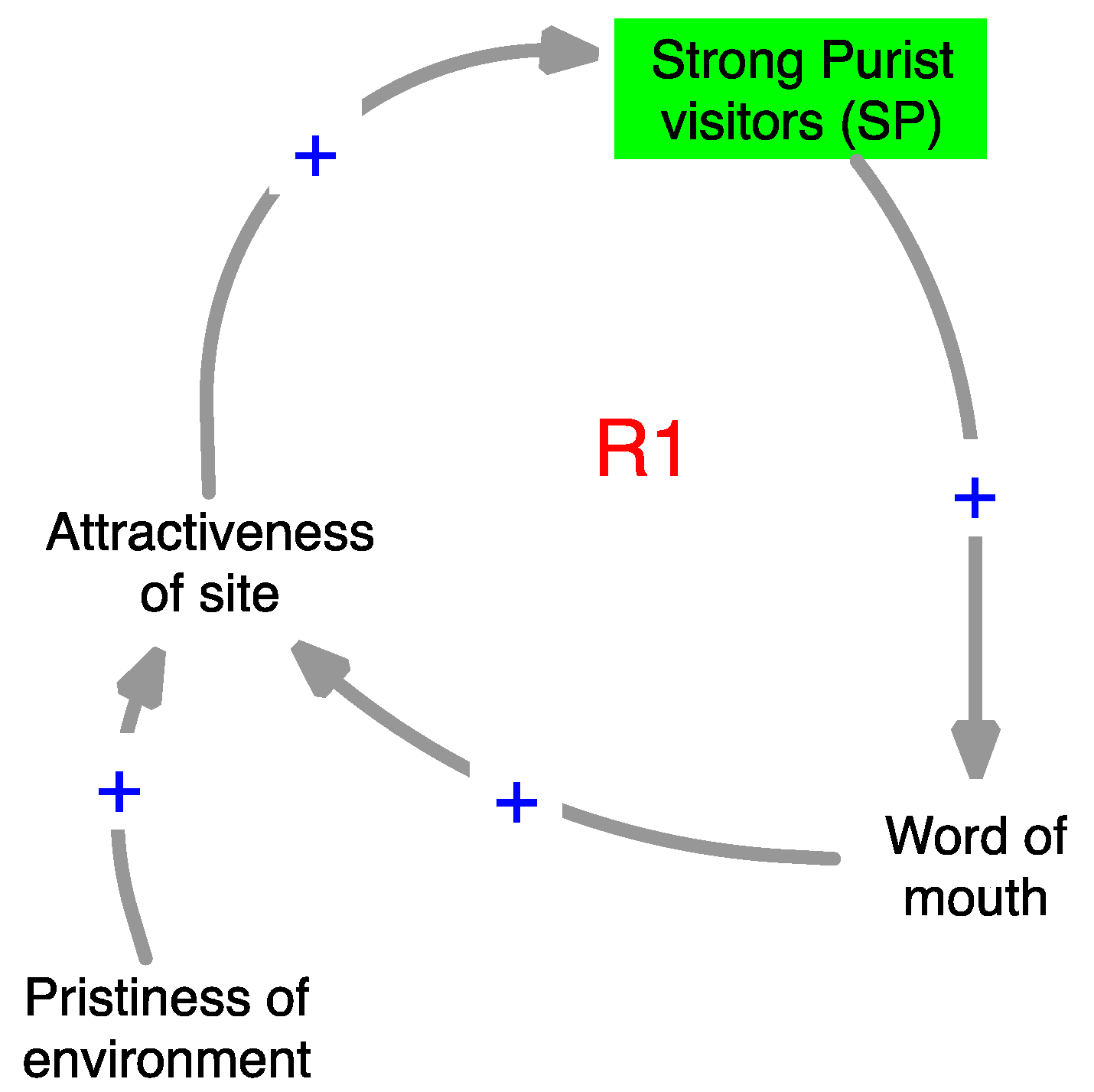
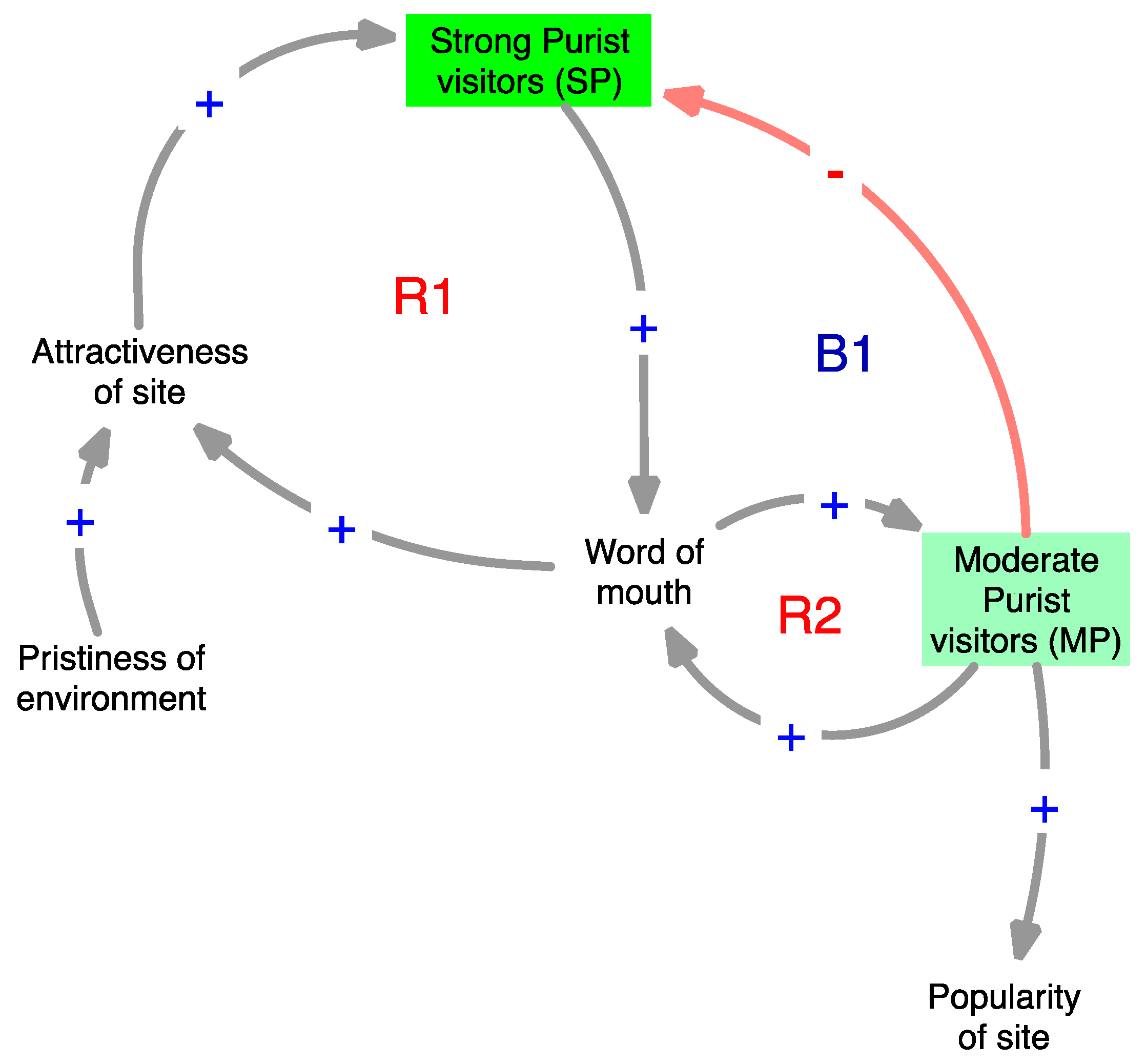
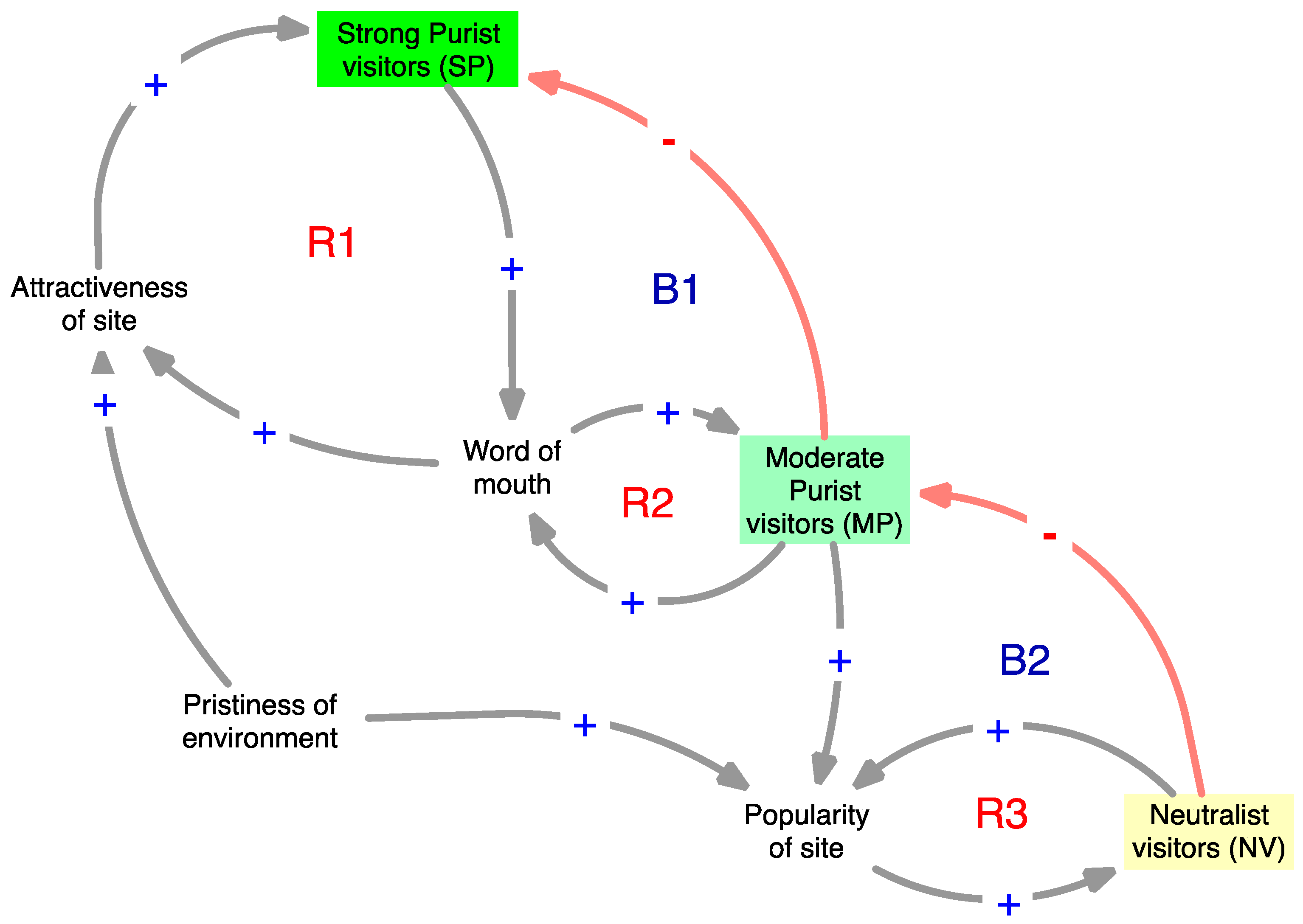
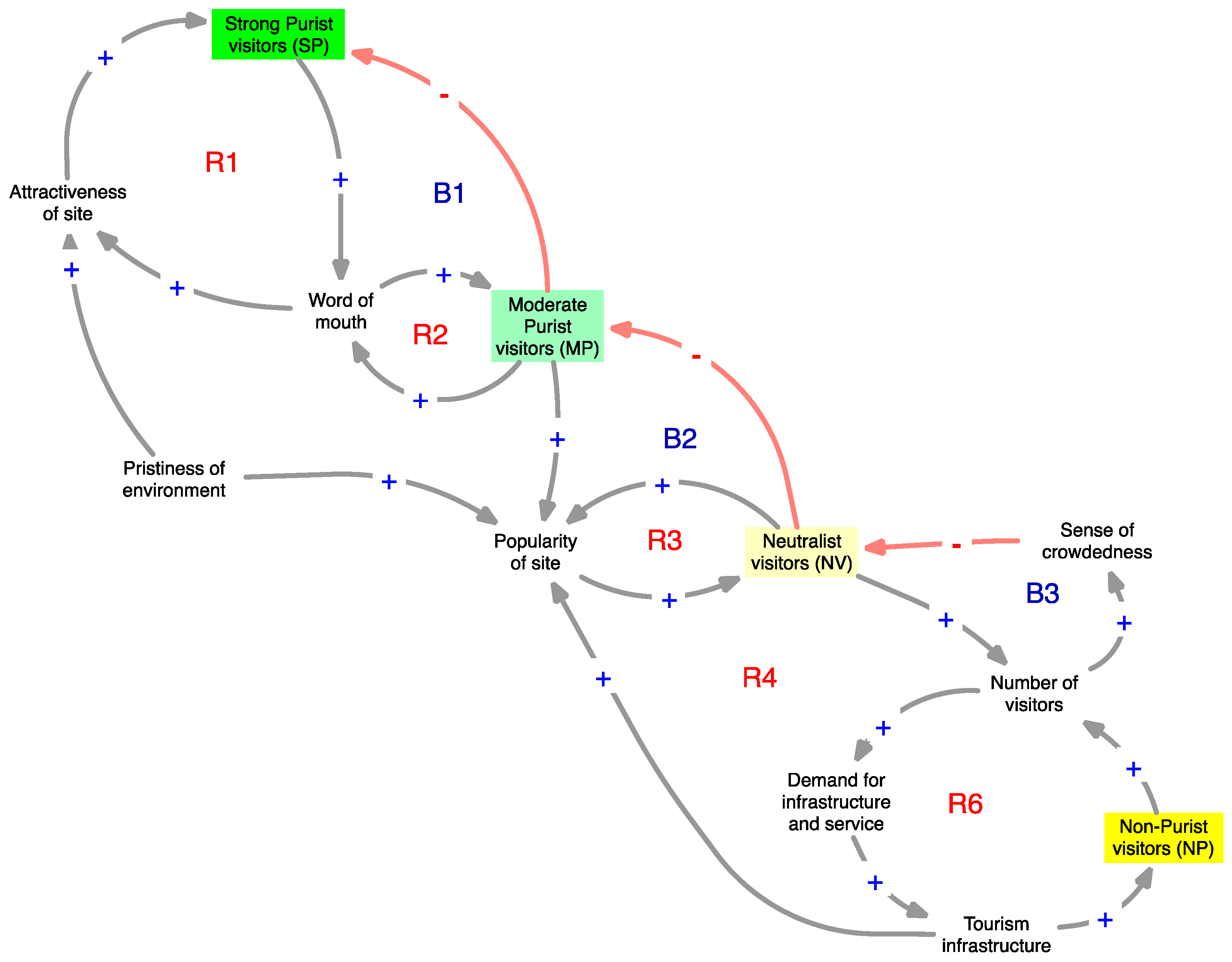
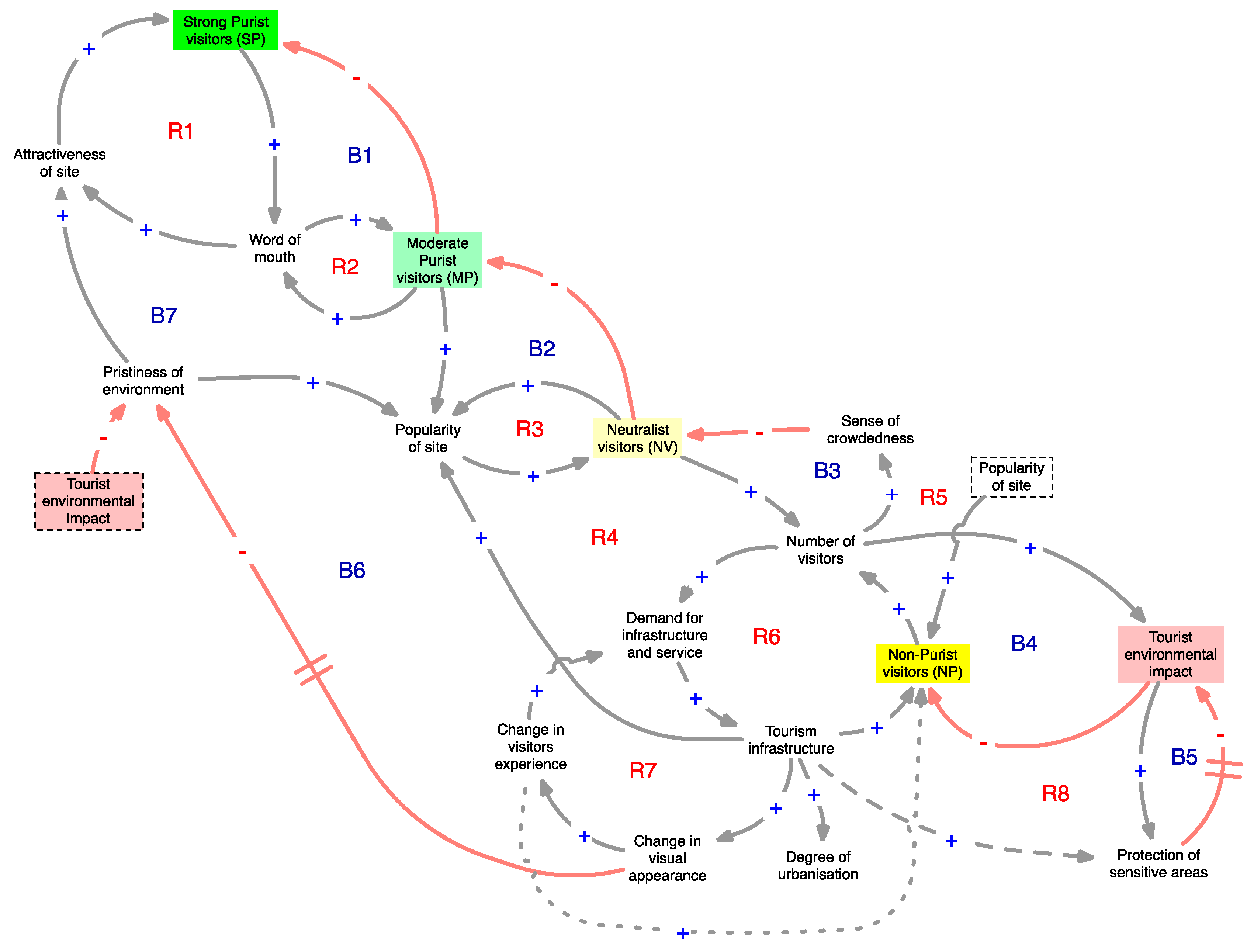

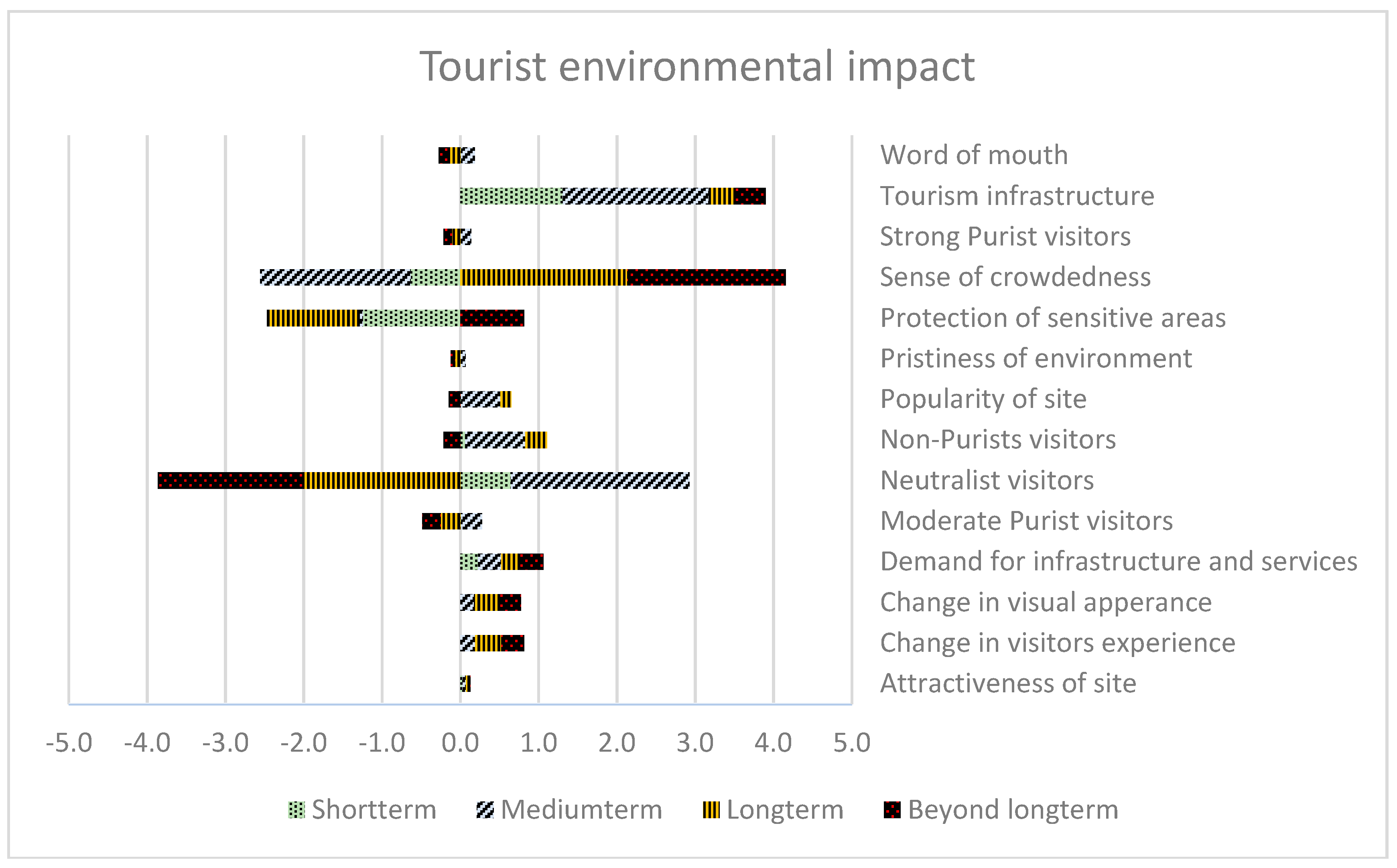
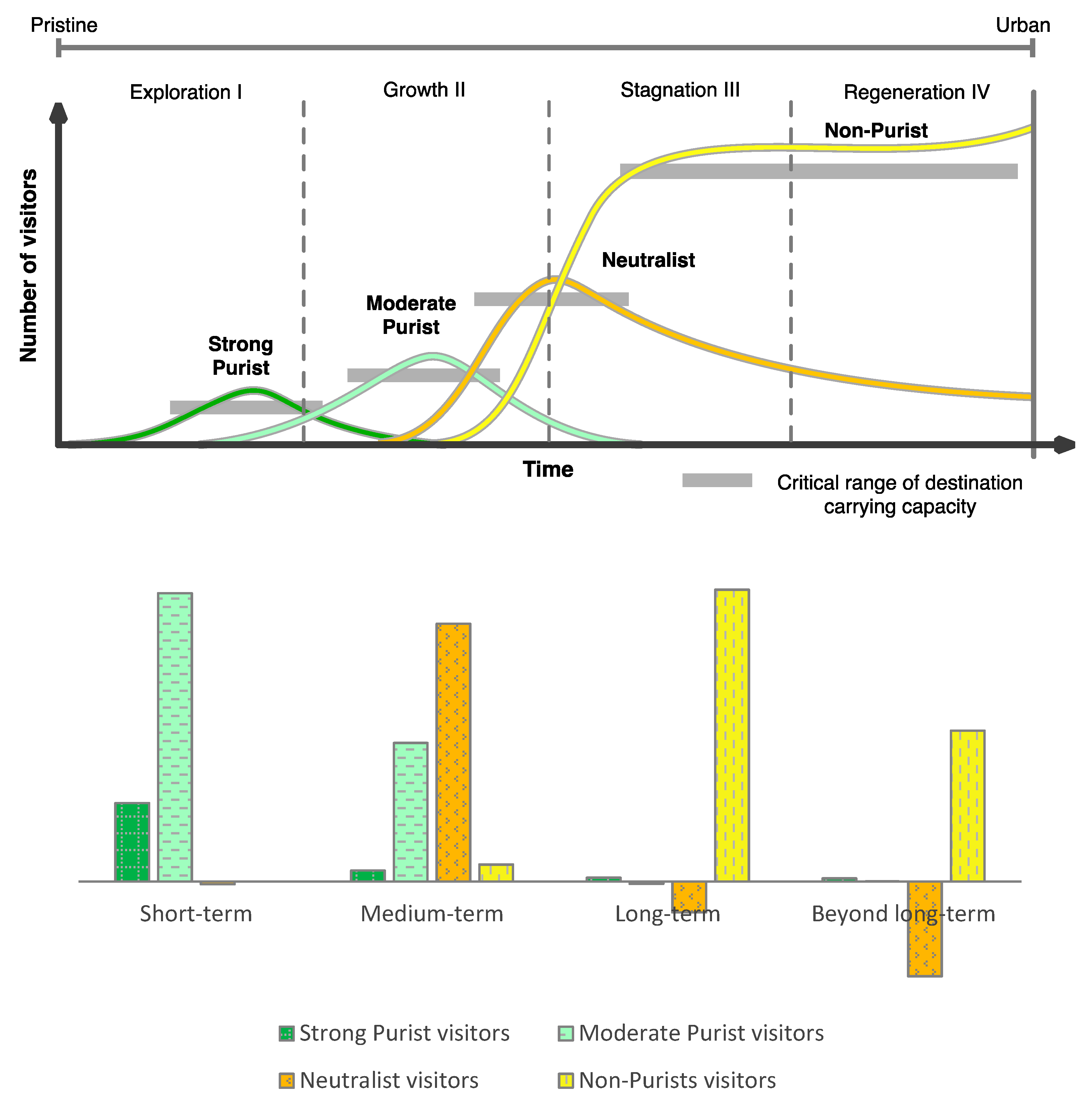
© 2018 by the authors. Licensee MDPI, Basel, Switzerland. This article is an open access article distributed under the terms and conditions of the Creative Commons Attribution (CC BY) license (http://creativecommons.org/licenses/by/4.0/).
Share and Cite
Haraldsson, H.V.; Ólafsdóttir, R. Evolution of Tourism in Natural Destinations and Dynamic Sustainable Thresholds over Time. Sustainability 2018, 10, 4788. https://doi.org/10.3390/su10124788
Haraldsson HV, Ólafsdóttir R. Evolution of Tourism in Natural Destinations and Dynamic Sustainable Thresholds over Time. Sustainability. 2018; 10(12):4788. https://doi.org/10.3390/su10124788
Chicago/Turabian StyleHaraldsson, Hördur V., and Rannveig Ólafsdóttir. 2018. "Evolution of Tourism in Natural Destinations and Dynamic Sustainable Thresholds over Time" Sustainability 10, no. 12: 4788. https://doi.org/10.3390/su10124788
APA StyleHaraldsson, H. V., & Ólafsdóttir, R. (2018). Evolution of Tourism in Natural Destinations and Dynamic Sustainable Thresholds over Time. Sustainability, 10(12), 4788. https://doi.org/10.3390/su10124788




